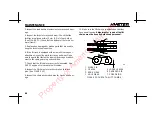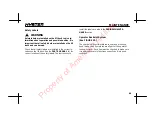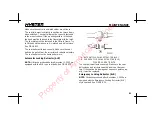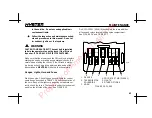
MAINTENANCE
99
switch in the starting circuit is closed so that the engine
can be started.
Service Brakes
Check the operation of the service brakes. Push on the
inching/brake pedal (or the brake pedal for units with a
manual transmission). The brakes must be applied before
the pedal reaches the floor plate. The brake pedal must
stop firmly and must not move slowly down after the
brakes are applied. The brakes must apply equally to both
drive wheels with no noticeable pull to either side. The
service brakes are automatically adjusted as the brakes
are applied when the lift truck changes direction.
WARNING
Loss of fluid from the brake fluid reservoir indicates a
leak. Repair the brake system before using the lift
truck. Replace the brake fluid in the system if there is
dirt, water or oil in the system.
The lift truck has a brake booster that receives power
from the hydraulic system. The brake pedal can be
hard to push when the engine is not running so that
the hydraulic system is not operating.
Parking Brake
Check the operation of the parking brake. The parking
brake, when in good condition and correctly adjusted, will
hold a lift truck with a capacity load on a 15% grade [1.5
metre rise in 10 metres (1.5 ft rise in 10 ft)]. Turn the knob
on the end of the hand lever to adjust the parking brake.
Do not tighten the adjustment so that the brake is applied
when the hand lever is released. The lever for the parking
brake has a lock. Use your finger to release the lock on
the lever when the lever is moved to release the parking
brake.
Lift trucks with a MONOTROL pedal:
when the parking
brake is applied, a switch in the starting circuit is closed so
that the engine can be started. The switch also puts the
transmission in
NEUTRAL
.
Steering System
WARNING
The lift truck has hydraulic power steering. The steer-
ing can be difficult if the engine is not running.
Make sure the steering system operates smoothly and
gives good steering control.
Property of American Airlines


































